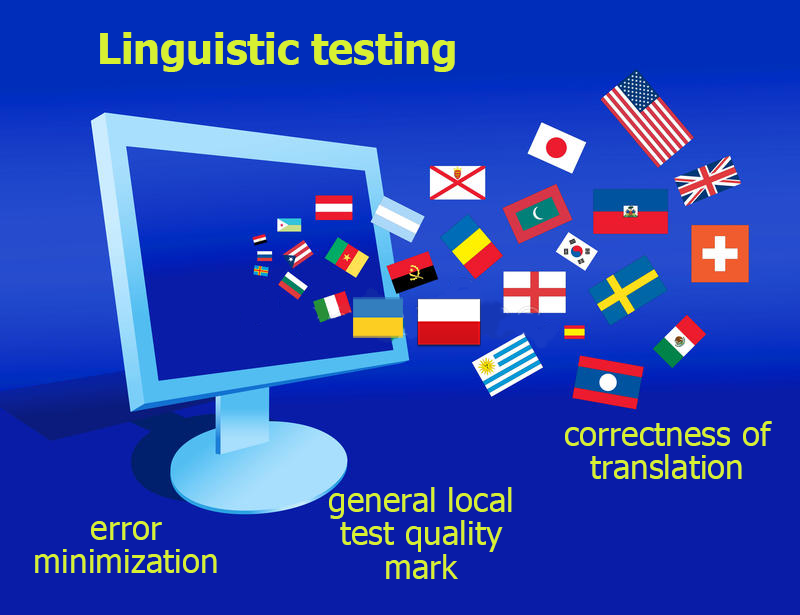If you do not perform linguistic testing of a product with localization components, then we can confidently say that it is poorly tested and contains a lot of critical bugs and defects.

Linguistic testing
The Need for Linguistic Tests
Even the most popular and well-functioning website, blog or any other software product should have the most integrated and high-quality translation of each word, as well as correct punctuation marks.
If the tester executes linguistic checks during the localization testing, he/she solves three tasks at once.
- This type of testing allows you to find lines for translation that are not in the graphical elements of the user interface: menus, various buttons, pop-up windows. The thing is that in some languages the length of one word can significantly differ from its translation. A simple example is a translation from Russian into French or German when the text length increases by 15-20%. In other words, the way how the interface looks is a very important thing. You should not forget about it during the localization testing. It is necessary to prioritize and constantly check the progress of such tests (for adding or editing words and phrases).
- QA engineer must ensure that all phrases of the translation have the original context and the natural meaning. A similar problem constantly arises during computer games testing. Commonly, a game has various bugs. It can be an incorrect conversion of units of measure, gender of virtual characters, incorrect designation of game elements, etc. Specialists should detect and fix all logical inconsistencies as correctly as possible (according to the semantic meaning).
- A tester should see how all the text blocks look in the software interface and whether the operating environment of the system affects them. Such a test allows you to find potential problems with an incorrect encoding of text blocks. For example, incorrect display of special characters in different languages (letters with a diacritical mark or with an umlaut).
How to Conduct Linguistic Testing
Let’s suppose that specialists translate all lines of program code with virtual translators and they successfully integrated all the system components into the final build.
A tester receives a localized product and now he/she needs to carefully review it again, examining each text block.
Note that linguistic testing is based not only on checking the translation of all the software graphical interface objects. Also, it includes checking system messages and warnings, complete translation of the Help block, and other accompanying technical documentation.
When the tester detects a bug, he/she should correct the file for translations and record the defect in the bug tracker. The most common bugs can be the following: untranslated blocks of text, missing words in sentences, incorrect date, and time format, incorrect order of displaying the name and surname, incorrect currency for some geographical area, etc.
It is a good practice to maintain a special bug list. Moreover, testers, developers, and a client of the product should have accessed to this list. Thus, the client can track online linguistic inconsistencies and tell the project team how to fix grammatical / semantic bug.
A Few Secrets of Linguistic Testing
#1
You can significantly simplify such verification at the stage of active translation of the text. The perfect option in this situation will be the automation of the translation process.
For such purposes, you can use a lot of tools and cloud services (Google Translator Toolkit, Crowdin, and WebTranslateIt). Such products allow using several translators on one project simultaneously. Also, you can use translation memory for potential corrections.
By the way, this is a really valuable and useful feature. System automatically saves each word translated on the project. And when it appears in the text again, the translator will be able to suggest a tester the correct option.
As a result, the translation will take less time and the number of potential corrections will not be so huge.
#2
It is worth to correctly structure the technical specifications for linguistic testing to understand that all work has been completed properly. Any similar technical task should explain to the translator how to examine all text blocks simultaneously and how to find hidden areas for translations (system messages, paid functionality in the product, bonus levels in computer games).
If we’re talking about games, linguistic testing here should be as comprehensive as possible. It means that a developer has to give tester access to cheat codes. Hence, the tester can quickly complete all levels and examine those parts of the text that have not yet been translated.
#3
Theoretically, linguistic testing should be done either by professional translators (you can invite a specialist to work temporarily in a software testing company), or native speakers of the necessary language.
Indeed, only a native speaker of the language of translation can quickly and efficiently shorten some words and phrases, estimate the peculiarities of the context and provide the most correct and relevant translation.
Conclusion
So, linguistic testing is an extremely important process, an intermediate stage of localization. You should always take it into account if you want to get a high-quality and fully tested product that will be used in different languages in different geographical regions.










Leave A Comment